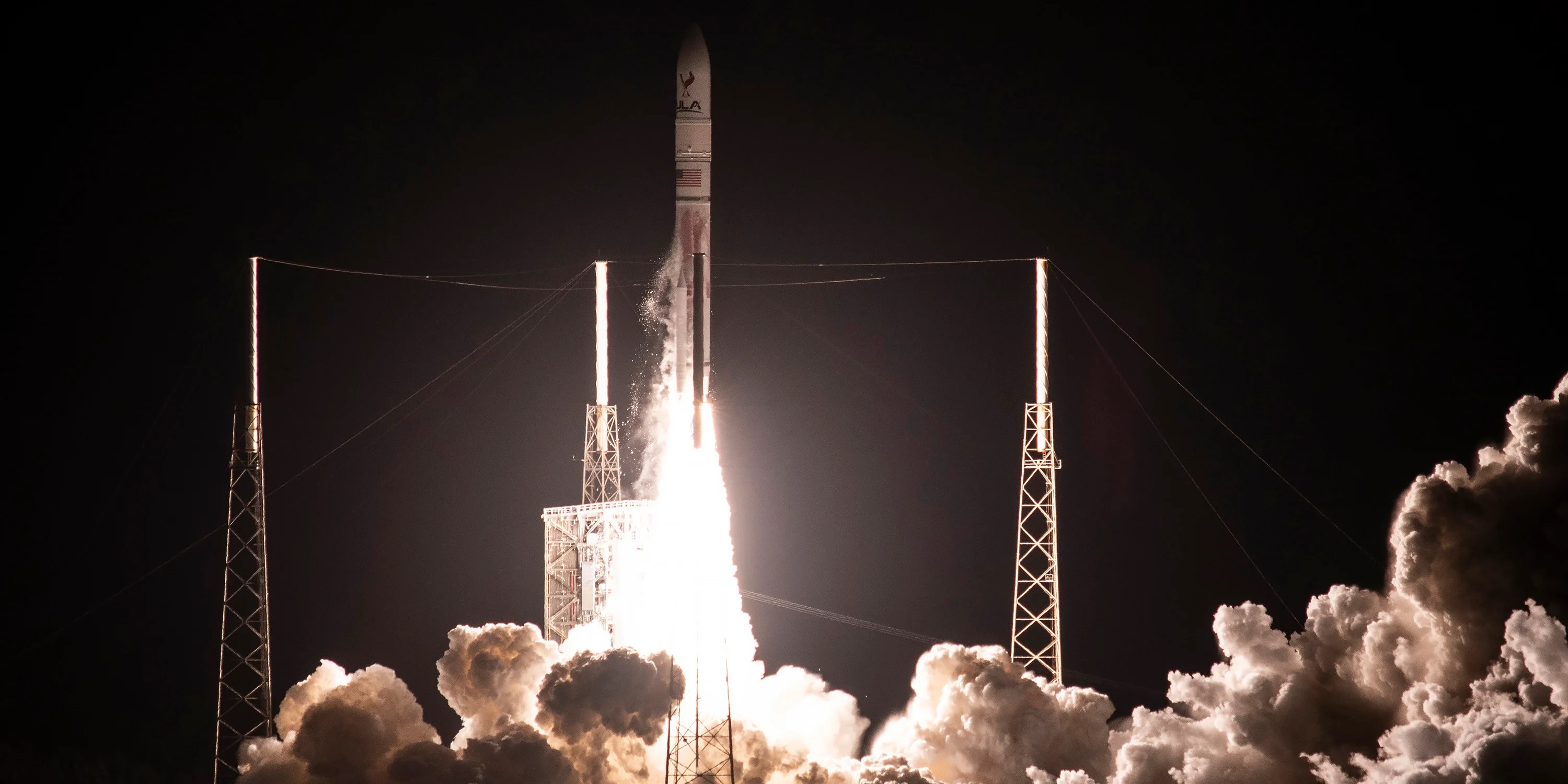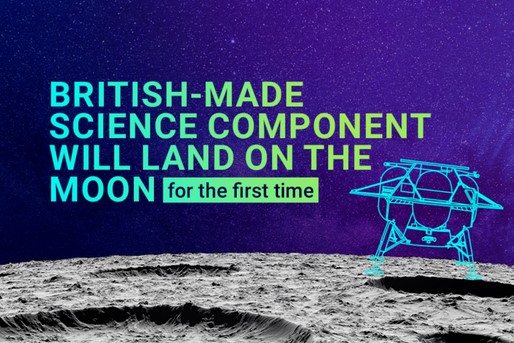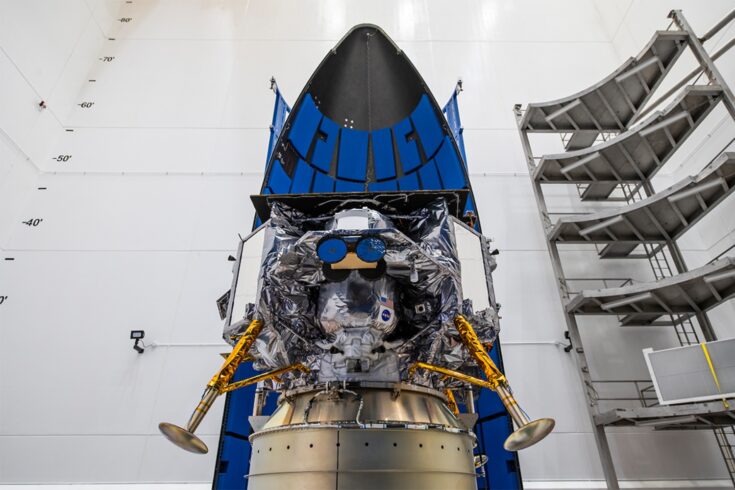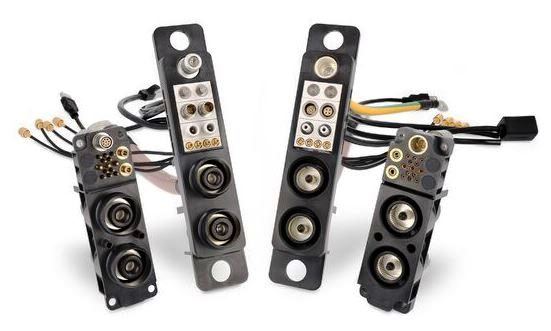ULA's Vulcan Rocket taking UK component to the moon

Above:
Vulcan launch this morning from Space Launch Complex-41 at Cape Canaveral Space Force Station.
Courtesy ULA
“Vulcan’s inaugural launch ushers in a new, innovative capability to meet the ever-growing requirements of space launch,” said Tory Bruno, ULA’s president and CEO. “Vulcan continues the legacy of Atlas as the world’s only high-energy architecture rocket.”
“The successful development and flight of this evolutionary rocket is a true testament to the unrivalled dedication and ingenuity of our workforce,” said Mark Peller, vice president of Vulcan Development. “Vulcan’s purpose-built design leverages the best of what we’ve learned from more than 120 combined years of launch experience with Atlas and Delta, ultimately advancing our nation’s space capability and providing unprecedented mission flexibility.”
The first certification flight (Cert-1) mission included two payloads:
- Astrobotic's first Peregrine Lunar Lander, Peregrine Mission One (PM1), as part of NASA’s Commercial Lunar Payload Services (CLPS) initiative to deliver science and technology to the lunar surface.
- Celestis Memorial Spaceflights deep space Voyager mission, the Enterprise Flight.
The Cert-1 mission served as the first of two certification flights required for the US Space Force’s certification process. The second certification mission (Cert-2) is planned to launch in the coming months, followed by a summer launch of the first Vulcan mission to support national security space.
“As we build on today’s successful launch, the team will continue to work towards our future bi-weekly launch rate to meet our customers’ manifest requirements, while continuing to develop future Vulcan upgrades including SMART reuse plans for downrange, non-propulsive recovery of Vulcan engines,” said Bruno.
ULA has sold more than 70 Vulcan launches to date, including 38 missions for Amazon’s Project Kuiper and multiple national security space launch missions as the part of the country’s Phase 2 launch procurement.

Image courtesy Department for Science, Innovation and Technology (DSIT) / UK Space Agency (UKSA)
UK space milestone
Astrobotic’s Peregrine Mission One will see an uncrewed spacecraft orbit the moon before landing on its surface, with science aiming to advance our understanding of the availability of resources such as water, which could be used for more sustained human exploration.
The Lunar Lander features a NASA science instrument called the ‘Peregrine Ion Trap Mass Spectrometer’ (PITMS), with an integral component, the Exospheric Mass Spectrometer (EMS), developed in the UK. The use of PITMS achieves historic milestone for UK space, as it will be the first UK and European science component to touch down on the surface of the Moon.
Peregrine Mission One will see the Peregrine Lunar Lander spend time orbiting Earth and then the Moon before beginning its dramatic descent and historic landing, expected to be around mid-February.
PITMS has been developed in the UK through £14 million of Government funding through the UK’s membership of the European Space Agency (ESA).
The PITMS instrument will explore the Moon’s atmosphere, by measuring water and other molecules, and unlock the mysteries of its ‘water cycle,’ as can be observed on Earth. This study of volatile substances - materials that can turn into gas – will provide valuable insights into lunar composition and conditions. The data collected will contribute to our understanding of the Moon’s potential to provide resources like water, opening new possibilities for future human presence on the lunar surface.
The UK-built component – called the Exospheric Mass Spectrometer (EMS) – was developed under an ESA contract by scientists at The Open University and RAL Space, the UK’s national space lab. It represents the first instrument on the Moon that has been built in the UK and in Europe and embodies the UK’s commitment to economic growth, showcasing the nation’s prowess in cutting-edge space technology.
As part of the PITMS, the Exospheric Mass Spectrometer allows researchers to study atoms and molecules in a gas. Lunar molecules in the Moon’s exosphere will enter the PITMS, be turned into ions, and then stored in an electric field – known as the ‘ion trap’. The ions are released from the trap into the detector, unveiling their chemical makeup and helping scientists to decipher the Moon’s composition.
The Peregrine Lunar Lander carries a suite of diverse NASA and commercial ‘payloads’ – often scientific or technological instruments, carried on board a spacecraft for a specific purpose. Notable among these commercial payloads are items which add a touch of human creativity to space exploration, including a time capsule, a bitcoin and even a music album.
Science and Technology Secretary, Michelle Donelan said: "The Exospheric Mass Spectrometer will be the first science component developed in the UK destined for the lunar surface, marking a historic moment for the UK space industry.
"This significant achievement also lays the groundwork for understanding how to sustain extended human presence on the Moon in the future – changing the way humankind interacts with the solar system around us forever.
"It is also a further sign of our close collaboration with international partners like NASA who I recently visited at the Johnson Centre, where we even discussed the potential for British astronauts to reach the moon in the future."
Understanding water on the Moon is an important part of the Artemis programme, to explore more of the lunar surface than ever before.
NASA contracted Astrobotic as its commercial partner and Peregrine Mission One to provide payload services via the Commercial Lunar Payload Services Initiative for five NASA-provided payloads, of which the PITMS is one.
Libby Jackson, Head of Space Exploration at the UK Space Agency, said: "The Peregrine Lunar Lander will help pave the way for further exploration of our Solar System. Witnessing the first instrument from the UK and indeed Europe, launch to the Moon is a hugely exciting moment. We are looking forward to seeing Peregrine safely on the surface and the return of important data from PITMS to help unlock the secrets of water on the moon.
"It’s fantastic to see our skilled UK experts at the heart of an international mission that will support future long-term presence in space."

Above:
The Peregrine Lunar Lander fuelled and integrated with United Launch Alliance’s Vulcan rocket. Courtesy Astrobotic
PITMS was developed in collaboration with the Science and Technology Facilities Council (STFC) RAL Space, The Open University (OU) and NASA’s Goddard Space Flight Center (NASA GSFC), funded through UK Space Agency and ESA. Commenting on RAL Space’s contribution, Prof. Mark Thomson, Executive Chair of STFC, said: "Ambitious plans for future space exploration, including crewed missions to the Moon and Mars, will need to be informed by new scientific data. The cutting-edge instrumentation on the Peregrine Lunar Lander will gather essential data from the surface of the moon, paving the way for future missions that will inspire the next generations. STFC and RAL Space are proud to have been able to provide our world-leading expertise in space technology to contribute to the success of this mission.
"The next step in human exploration of the Solar System may utilise the Moon as a stepping stone to make that journey feasible. STFC’s RAL Space team of engineers and scientists have already been involved in over 200 space missions and this latest work that supports the PITMS mission to the Moon will give us an opportunity to better understand the sources of water on the Moon. This is important in the understanding of the potential to harvest lunar water as a resource to support both future human exploration mission and the establishment of a long-term lunar base."
Christopher Howe, Production and Software Group Leader at RAL Space, said: "The use of the Moon’s water could prove vital for future human endeavours in space, so we’re incredibly proud to have had the opportunity to help develop PITMS and are delighted to see it safely on its way. The technology from PITMS will now help underpin instruments on future missions, such as the Rosalind Franklin Rover, so whilst PITMS will only operate for one lunar day on the moon, its legacy will be felt for years."
Roland Trautner, ESA EMS Project Manager said: "As the first ESA payload destined to land on the lunar surface, the Exospheric Mass Spectrometer (EMS) - which forms the heart of the ESA-NASA PITMS instrument - is a groundbreaking instrument for ESA, both as a technology demonstrator and for lunar science. PITMS will answer key questions on the Moon’s exosphere and its evolution, providing invaluable insights into availability and possible utilisation of potential resources for future space exploration, including production of fuel, food and energy. The EMS technology is also a key building block for future instruments for lunar exploration, and new flight opportunities have been identified already."
Spacebit tribute on Peregrine Mission One
Ahead of sending Britain's first ever rover to the moon - due later this year - British-Ukrainian space entrepreneur, Pavlo Tanasyuk, founder and CEO of UK-Luxembourgish space exploration enterprise, Spacebit, is paying tribute to the people of Ukraine by sending a metallic version of its flag aboard the Peregrine Mission One.

Above:
Spacebit’s space-graded metallic tribute to the people of Ukraine.
Image PRNewsfoto / Spacebit
Pavlo gained global recognition in 2019 for having developed Britain's first ever moon rover, known as Asagumo, the deployment of which was delayed due to Covid. It is the smallest robotic moon rover in the world and the first to be designed with spider like legs – hence the name Asagumo, taken from the Japanese morning spider Asa no Kumo that brings good luck. The Spacebit Asagumo moon rover launch is scheduled within a year.
Peregine launch goals
Spacebit's aim for the Peregrine Mission One comprises material science goals. Pavlo said: "The payload that we are sending consists of various materials that include metals and different space-graded coatings. We hope to test these materials during the flight and lunar conditions so that we can progress to higher TLR (flight readiness level) for the moon-launch of the Asagumo rover.
"The Spacebit payload also includes a laser edged Union Jack along with artwork by Sacha Jafri and a number of blockchain related payloads that are helping us to fund future missions."
Tribute to Ukraine
Spacebit is sending a Ukraine metallic embossed flag that includes a map of the country in solidarity with Ukrainian people. This metallic plate uses a new type of coating that has never been tested on the lunar surface before. These paints are water-based and can withstand extreme temperature conditions for hundreds of years to come. A copy of the plate was presented to president Zelensky prior to Russia's most recent invasion of Ukraine.
Peregrine Mission One or the Peregrine Lunar Lander is a lunar lander built by Astrobotic Technology, that was selected through NASA's Commercial Lunar Payload Services.
















